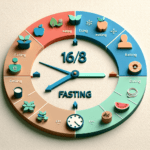So, you’ve heard all the buzz about fasting and you’re curious to give it a try. Well, fear not, because this article is here to guide you through the process! In this beginner’s step-by-step guide, we’ll walk you through everything you need to know to start fasting. From understanding the different types of fasting to creating a fasting schedule that works for you, we’ve got you covered. So, grab a pen and paper and let’s get started on your fasting journey!

Understanding Fasting
What is fasting?
Fasting is a voluntary practice where you abstain from consuming food or drink for a certain period of time. While it has been practiced for centuries for various reasons, it has gained popularity in recent years due to its potential health benefits.
Why do people fast?
People fast for a variety of reasons. Some individuals fast for religious or spiritual purposes, while others may fast for health and weight loss benefits. Fasting has also been used as a form of detoxification and as a way to improve mental clarity and focus.
Different types of fasting
There are several different types of fasting that you can choose from depending on your goals and preferences. Some common types include intermittent fasting, where you cycle between periods of eating and fasting, and alternate-day fasting, where you fast every other day. There are also longer-term fasts, such as extended water fasts, where you only consume water for a prolonged period.
Benefits of fasting
Fasting has been associated with numerous health benefits. Some studies suggest that it may help with weight loss, improve insulin sensitivity, reduce inflammation, and even promote longevity. However, it is important to note that the research on fasting is still evolving, and individual results may vary.
Preparing for Fasting
Consult your healthcare provider
Before embarking on a fasting journey, it is crucial to consult with your healthcare provider, especially if you have any underlying medical conditions or are taking medications. They can provide personalized advice and ensure that fasting is safe for you.
Choose the right fasting method
With so many different fasting methods available, it’s important to choose one that suits your lifestyle and goals. Consider factors such as your eating habits, work schedule, and medical history when selecting a fasting method. It’s always best to start with a shorter fasting duration and gradually increase it as you become more comfortable.
Set realistic goals
Setting realistic goals is essential for a successful fasting experience. Instead of aiming for dramatic weight loss or lengthy fasting periods right away, start with small, achievable goals. This will help you stay motivated and prevent feelings of frustration or disappointment.
Create a fasting schedule
Having a fasting schedule can provide structure and make it easier to stick to your chosen fasting method. Plan your fasting periods and non-fasting windows in a way that aligns with your daily routine and allows for flexibility when needed. It’s important to listen to your body and adjust the schedule if necessary.
Building Up to Fasting
Start with intermittent fasting
If you’re new to fasting, starting with intermittent fasting can be a great way to ease into the practice. This method involves fasting for a certain number of hours per day or alternating fasting days with regular eating days. It allows your body to gradually adapt to fasting and can be easier to incorporate into your lifestyle.
Adjust your diet
As you prepare for fasting, it’s important to adjust your diet to ensure you’re getting nourished with the right nutrients. Focus on consuming a balanced diet that includes plenty of fruits, vegetables, lean proteins, and whole grains. Avoid processed foods and excessive sugar or caffeine, as they can make the transition to fasting more challenging.
Gradually increase fasting duration
Once you feel comfortable with intermittent fasting, you can gradually increase the duration of your fasting periods. Start by adding an hour or two to your fasting window and monitor how your body responds. If you experience any adverse effects, such as extreme hunger or dizziness, consider going back to a shorter fasting duration until you feel ready to progress.
Monitor your hunger levels
During the building phase of fasting, it’s important to pay attention to your hunger levels. While it’s natural to feel some hunger, extreme or prolonged hunger may indicate that you need to adjust your fasting approach. Experiment with different fasting methods and durations to find what works best for your body.

Managing Hunger and Cravings
Stay hydrated
Hydration is key when fasting. Drink plenty of water throughout the day to help keep you feeling full and to prevent dehydration. Herbal teas and infused water can also be a great way to add flavor without breaking your fast.
Eat balanced meals during non-fasting periods
When you are not fasting, focus on consuming balanced, nutritious meals that incorporate protein, healthy fats, and fiber-rich foods. These components will help keep you feeling satiated for longer and provide essential nutrients for your body.
Include fiber-rich foods in your diet
Fiber-rich foods, such as fruits, vegetables, and whole grains, can help reduce hunger and control cravings. They add bulk to your meals, promoting a feeling of fullness and preventing overeating during non-fasting periods.
Use distraction techniques
When cravings strike, distraction techniques can be helpful in shifting your focus away from food. Engage in activities that keep your mind occupied, such as going for a walk, reading a book, or spending time with friends or family. Finding healthy outlets for stress and boredom can make fasting more manageable.
Dealing with Potential Side Effects
Headache and fatigue
Headaches and fatigue are common side effects when starting fasting. They are usually temporary and may be a result of your body adjusting to the new eating pattern. Ensure you stay hydrated, get enough rest, and consider supplementing with electrolytes if needed. If symptoms persist or worsen, consult your healthcare provider.
Digestive issues
Some individuals may experience digestive issues, such as bloating or constipation, when fasting. To prevent these discomforts, make sure to consume adequate fiber-rich foods and stay hydrated. If problems persist, consider incorporating probiotics into your diet or adjusting your fasting method.
Low blood sugar
If you have diabetes or issues with low blood sugar, fasting may require extra caution. Monitor your blood sugar levels regularly and consult with your healthcare provider to determine a fasting approach that suits your condition. It may be necessary to modify your fasting method or incorporate small, balanced snacks during fasting periods.
Muscle loss
While fasting can lead to weight loss, it’s important to minimize muscle loss. To preserve muscle mass, ensure you consume enough protein during non-fasting periods and maintain a regular exercise routine that includes strength training. If you have concerns about muscle loss, consider consulting with a registered dietitian or fitness professional.
Listening to Your Body
Pay attention to warning signs
When practicing fasting, it’s crucial to listen to your body and be aware of any warning signs. If you experience extreme dizziness, weakness, confusion, or any other concerning symptoms, stop fasting immediately and seek medical attention.
Modify your fasting approach if needed
Fasting should be a flexible practice that suits your individual needs. If you find that a particular fasting method is causing excessive discomfort or negatively impacting your overall well-being, don’t hesitate to modify or switch to a different approach. Remember, everyone’s body is unique, and what works for one person may not work for another.
Don’t push yourself too hard
It’s important to strike a balance between pushing yourself to achieve your fasting goals and taking care of your overall health. Pushing too hard or setting unrealistic expectations can lead to burnout or disordered eating patterns. Listen to your body’s signals and be kind to yourself throughout the fasting journey.
Seek professional help if necessary
If you’re struggling with fasting or have concerns about potential health risks, don’t hesitate to seek professional help. Consulting with a registered dietitian, nutritionist, or healthcare provider who specializes in fasting can provide personalized guidance and support.
Supporting Your Fasting Journey
Inform close friends and family
Informing close friends and family about your fasting journey can help create a supportive environment. They can provide encouragement, understand your dietary restrictions during fasting periods, and help you stay accountable to your goals.
Join a fasting support group
Joining a fasting support group or an online community can provide motivation, tips, and encouragement when navigating your fasting journey. You can share experiences, ask questions, and learn from others who have similar goals or experiences with fasting.
Find a fasting buddy
Having a fasting buddy can be beneficial in providing mutual support and motivation. Consider finding a friend or family member who is also interested in fasting and embark on the journey together. You can share your experiences, keep each other accountable, and celebrate milestones together.
Educate yourself
Take the time to educate yourself about fasting. Read books, articles, and reputable online resources to learn about different fasting methods, tips, and potential pitfalls. The more knowledge you have, the better equipped you will be to make informed decisions and take control of your fasting journey.
Staying Motivated
Set achievable short-term goals
To stay motivated throughout your fasting journey, set short-term goals that are realistic and attainable. Instead of solely focusing on long-term weight loss or health outcomes, break down your goals into smaller milestones that you can celebrate along the way.
Track your progress
Tracking your progress can help you stay motivated and see the positive changes that fasting brings to your body and overall well-being. Keep a journal, use smartphone apps, or utilize wearable fitness trackers to monitor your fasting periods, eating habits, and any accompanying changes in weight, energy levels, or mental clarity.
Reward yourself
Celebrate your achievements by treating yourself to non-food rewards. It could be buying a new outfit, taking a relaxing bath, or doing something you enjoy. The rewards serve as positive reinforcement and remind you of the progress you’ve made on your fasting journey.
Celebrate milestones
When you reach significant milestones, take a moment to acknowledge and celebrate your accomplishments. Share your achievements with friends and family, treat yourself to a special meal (within your dietary requirements), or simply reflect on how far you’ve come. Celebrating milestones can further fuel your motivation and commitment to fasting.
Breaking Your Fast
Start with small, easily digestible foods
When breaking a fast, it’s essential to reintroduce food slowly and with caution. Begin with small, easily digestible foods, such as fruits, vegetables, or light soups. This will give your digestive system time to adjust and prevent any discomfort.
Avoid overeating
After a period of fasting, it can be tempting to indulge in large quantities of food. However, it’s important to listen to your body’s signals of hunger and fullness and avoid overeating. Opt for smaller, more frequent meals during the initial refeeding phase to help your body readjust to regular eating.
Listen to your body’s signals
Your body will provide signals to let you know when you are hungry or full. During the refeeding phase, pay attention to these signals and eat mindfully. Chew your food thoroughly, savor each bite, and stop eating before you feel overly full. Trust your body’s cues and honor its needs.
Transition back to regular eating gradually
After breaking a fast, it’s advisable to transition back to your regular eating habits gradually. Slowly reintroduce a wider variety of foods, but continue to prioritize balanced meals and healthy choices. This will help prevent digestive discomfort and allow your body to adjust to regular eating.
Maintaining a Healthy Lifestyle
Eat a balanced and nutritious diet
Even when not fasting, it’s important to maintain a balanced and nutritious diet. Focus on whole, unprocessed foods that provide essential nutrients for your body. Include a variety of fruits, vegetables, lean proteins, whole grains, and healthy fats in your meals to support overall health.
Stay physically active
Engaging in regular physical activity is a crucial component of a healthy lifestyle. Find activities you enjoy, whether it’s walking, jogging, dancing, or practicing yoga, and incorporate them into your routine. Exercise can help maintain muscle mass, boost mood, and support overall well-being.
Manage stress levels
Stress can impact your fasting experience and overall health. Find stress-management techniques that work for you, such as meditation, deep breathing exercises, or engaging in hobbies. Taking time for self-care and prioritizing stress reduction can enhance the benefits of fasting and support your overall well-being.
Prioritize quality sleep
Getting quality sleep is vital for overall health and well-being. Aim for seven to nine hours of sleep each night, and establish a relaxing bedtime routine to promote restful sleep. Sufficient rest allows your body to recover, repair, and optimize the benefits of fasting.
As you embark on your fasting journey, keep in mind that the experience will be unique to you. Listen to your body, set realistic goals, and seek support when needed. Fasting can be a powerful tool for improving health and well-being, but it’s important to approach it with care and respect for your individual needs.







